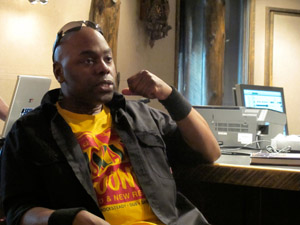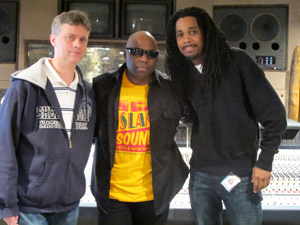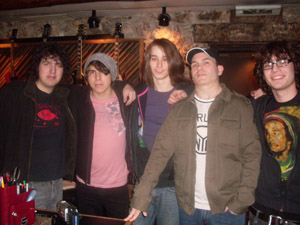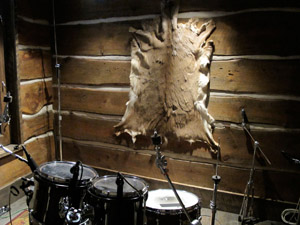Back At Manhattan Center, Hardgroove Opens The Fuse Box
MIDTOWN MANHATTAN: Public Enemy musician/producer Brian Hardgroove has returned to Manhattan Center, the 34th Street entertainment and studio complex where he came up as an assistant in the 90s. Hardgroove has taken over and reconfigured Studio 4, renaming it “The Fuse Box,” after his nationally syndicated radio show, which will now be produced out of this studio.
Beyond the radio show, Hardgroove’s mission with The Fuse Box is to provide a top-notch recording and mixing environment for developing talent.
This idea was well illustrated when we visited The Fuse Box just a few weeks ago, as teenage rock band Comic Book Heroes was in session with producer Jimmy Landry. Comic Book Heroes was tracking four new songs — two of which will go to ESPN where they are the featured 2010 band for NASCAR and all of which will go for their upcoming full-length record.
“These guys are certainly on the radar right now, but they’ll be on the map within the year,” says Hardgroove of the band. “When Jimmy approached me about working here, and I met with the band and their manager, I saw that they have the right kind of support behind them — they’re smart and they’ve got their bases covered, and I can throw the studio’s weight behind supporting that. And that’s exactly what I’m here to do.”
Working with manufacturer-sponsors including Sennheiser, Cakewalk and TC Electronic, not to mention a fantastic Neve VR-equipped studio to begin with, Hardgroove has created an environment to serve as an incubator for emerging talent.
“The Manhattan Center was originally built as an artistic center, to be a home for artists who could really make something of their talent,” says Hardgroove. “When the owners suggested I come back and base myself out of one of their studios, I thought back to the origins of this entire place and found that we were all on the same page about what I could do to help cultivate great music here. I’d originally thought of taking over one of the old studios on the 8th Floor, but as the plans developed, we decided I should use the showcase room.”
THE LOG CABIN ON 34th STREET
Manhattan Center’s Studio 4 has a large live room and access to even larger live rooms (The Grand and Hammerstein Ballrooms!), awesome Adirondack-style log cabin aesthetic, impeccably maintained equipment and a rich history. In the last decade, this is the studio where Jimmy Douglass recorded and mixed so many Timbaland-produced hits. As The Fuse Box, a new wave of artists and producer/engineers will gain access to this classic room, newly endowed with an incredible microphone collection and multi-platform DAW capabilities.
“I believe you need a good technical environment to develop talent, almost as much as you need the talent itself,” says Hardgroove. “Jimmy Hendrix, one of the great American talents, had technology and an amazing engineer, Eddie Kramer, by his side constantly and they worked in places like this to make his music what it was.”
To augment the already high-end technical environment, Hardgroove called on some of his favorite brands. “I thought if I can get the manufacturers to support this studio the way they’ve supported me as an artist, then maybe we can get something new and cool going on here,” says Hardgroove. He called on Sennheiser, Cakewalk, TC Electronic and Gibson.
“I called David Missall at Sennheiser, and we spent 45 minutes talking music before we ever started talking gear,” Hardgroove notes. “We talked about how the studio would be a showplace for Sennheiser, while simultaneously supporting emerging artists. He totally got it and was behind the idea. He asked me to put a list of mics together, which I did, and then he added to that. Suddenly, we had this banging collection of Sennheiser and Neumann mics coming in!
The Fuse Box microphone cabinet filled out with Sennheiser MKH 8020, 8040, 800-P48, 800 Twin, MD 441, 421 and e series microphones as well as Neumann’s TLM 103 Anniversary, TLM 49 and TLM 67 SET Z.
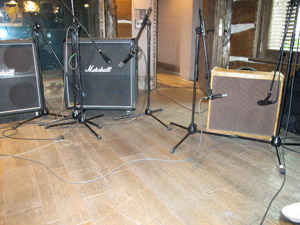
Comic Book Heroes' guitar tracking setup: (l-r) Marshall 4x12 miked by Sennheiser MD 421, 441 and e906; vintage Fender Bassman miked up by Sennheiser 421 and 441s
“I had similar conversations with Cakewalk, Gibson and TC. They all ‘got it,’ they saw it as an opportunity to showcase their gear and wanted help get the word out about the studio. It was a total win-win.”
Hardgroove hooked up with Cakewalk’s Steve Thomas through Public Enemy DJ/producer Johnny Juice. Cakewalk provided a SONAR V-Studio 700 and a range of synths and controller keyboards, making The Fuse Box a dual-platform room running Pro Tools and Sonar.
“Our hardware is platform agnostic — we can play with everybody,” notes Thomas. “Our involvement is not so much about getting people to use Cakewalk, as it is about supporting an artistic environment by providing choices so that people can work with whatever they’re comfortable using.”
In The Fuse Box, Hardgroove has built an environment that’s inspiring and comfortable for artists at any level, and exciting for engineers. The studio has a Neve VR-72 console, ample outboard equipment, large live room with isolated drum room, full kitchen and lounge, and an acoustically treated office that can double as a second production room. Big rock, acoustic jazz, intimate singer/songwriters, horn sections, string sections, what have you — this room will accommodate all in the name of producing great content.
“I wanted to create a place that would be an incubator for good music, and Manhattan Center is giving me a lot of latitude to be able to bring people in and be flexible with pricing,” says Hardgroove. “Comic Book Heroes, for example, are here at a super discounted rate. The idea is to get great artists in here, to support bands that can really blow up and do something, and in the process, build a studio that’s super hip.
“We’ll also be building a production/publishing arm of the company as well, where we’ll be able to provide songs and songwriting so that we’ll be able to participate in the back end of some of these projects.”
PHILOSOPHY IN PRACTICE: COMIC BOOK HEROES
For Comic Book Heroes, whose members are still in high school in Pennsylvania, coming to work at a top-notch Manhattan recording studio is a huge thrill.
“This is only our second time in the studio for an extended amount of time — and our first experience was a good one,” says lead singer/guitar player Ned Goldberg, “But this is a total step-up equipment-wise. It’s so extremely comfortable. I keep saying that I want to live here! We’ve been recording for five days and we’re excited to come back next week to mix.”
Producer/engineer Jimmy Landry first heard the band at SXSW in ’07. “I was way in the back of the room, and it was the worst-sounding PA you could ever imagine, but Ned’s voice cut through and I was won over,” Landry says. Soon after meeting the band, he began working with them, and produced/engineered and co-wrote their ’08 EP, Take a Seat.
“The last record I did with Comic Book Heroes, we were in a basement in Brooklyn, literally underground with a rack of 1073s and an API Lunchbox. And it sounded great, but we were all on top of each other.” In contrast, says Landry, “Working at The Fuse Box is totally refreshing. There’s no question, you really do get more creative in an environment like this. And it’s far less fatiguing. For the last four days I’ve been looging some serious ‘midnight candle hours’ and it really doesn’t feel like that. It’s so comfortable, not to mention the gear is ridiculous and it’s all in amazing shape. I have not experienced one glitch in this place. Not one.”
Keeping it all running so smoothly is Manhattan Center’s chief technician, Joel Scheuneman, and chief engineer Darren Moore.
Johnny Juice points out, “Engineers are key. That’s something that’s really been missing, as kids come up working on Mbox’s trying to be all these people at once — musician, songwriter, producer, engineer — and maybe not being good enough at any of them.
Here, Brian will be eliminating those obstacles for an up-and-coming artist by providing pro engineers, pro gear, great rooms; this fosters the idea that you don’t have to be some monolithic genius, like Prince. He’s able to do all of those things expertly but that is a rarity!”
In addition to scouting out next-big-thing artists of every genre to bring into The Fuse Box, Hardgroove will also be bringing his own projects through the studio, including upcoming sessions with Bootsy Collins and Fred Schneider. And the facility can expand for larger-scale projects.
“When I’m working with Juice on the sessions with Bootsy and Fred, we’ll set him up in the B room and then the place will be humming. Then there’s some vibration in the joint,” he emphasizes. “These days, everyone’s working from 500 miles away and people are bragging about the solo they did in their slippers — where’s the spirit in that? We all grew up with people making music together and I don’t think that’s old-fashioned. I think it’s more fun and I think you have a better chance of tapping into the universe, doing something special.”
Get in touch with Brian Hardgroove and The Fuse Box via http://www.myspace.com/brianhardgroove. For more information on Manhattan Center Studios, visit: http://www.mcstudios.com. And, check out Comic Book Heroes at http://www.myspace.com/cbhmusic and Jimmy Landry at http://www.audiostrike.com.
Please note: When you buy products through links on this page, we may earn an affiliate commission.







